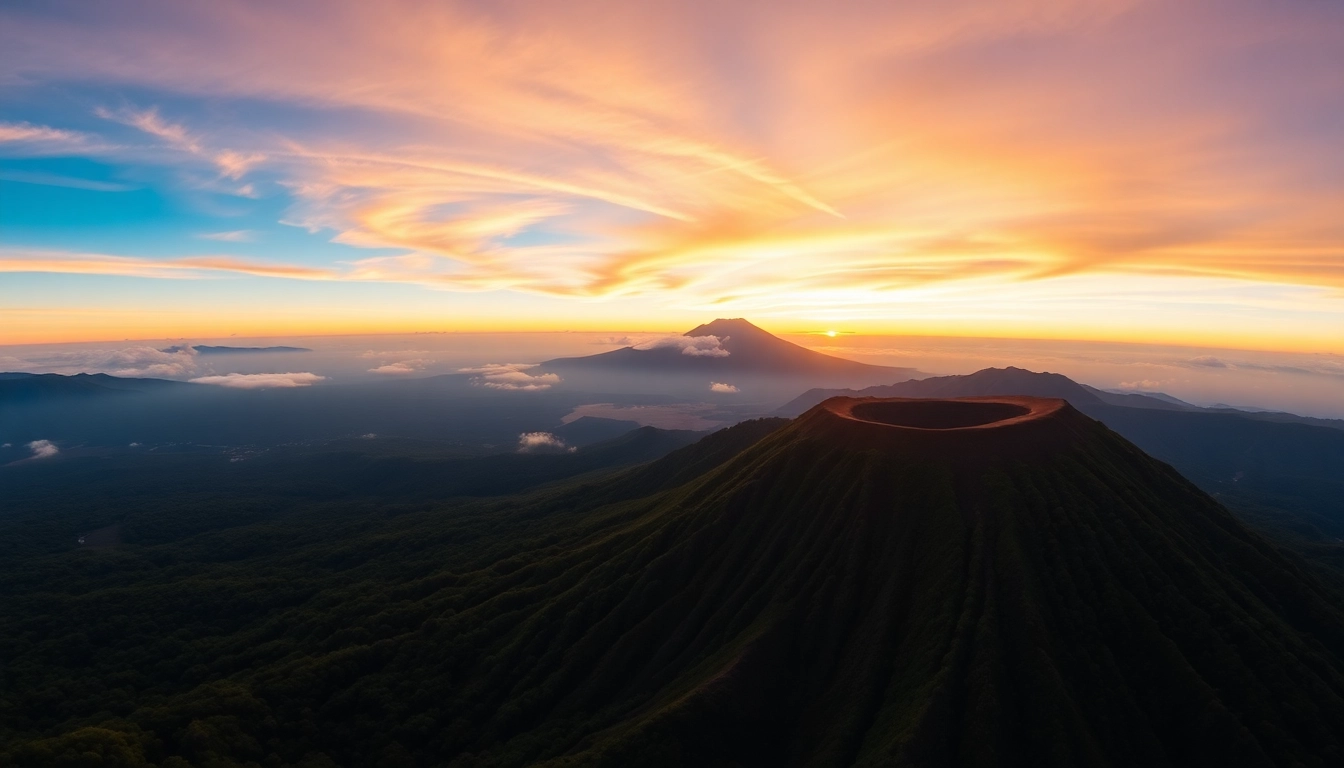Climbing Mount Rinjani: Your Complete Guide to Indonesia’s Majestic Volcano

Understanding Mount Rinjani: The Iconic Volcano of Lombok
Rising majestically from the island of Lombok in Indonesia, Mount Rinjani stands as the second-highest volcano in Indonesia and one of Southeast Asia’s most awe-inspiring natural wonders. Its towering presence, dramatic landscapes, and rich geological history have made it a magnet for adventure seekers, nature lovers, and cultural explorers alike. This comprehensive guide delves into the intricate details of Rinjani—its geographical significance, geological history, diverse ecosystems, and the thrilling treks that draw thousands annually to set foot on its slopes.
Geographical Location and Significance
Mount Rinjani is located in the northern part of Lombok, within the boundaries of the Gunung Rinjani National Park, which spans over 41,000 hectares. Situated approximately 1,800 meters above sea level at its base, it rises to a commanding height of 3,726 meters (12,224 feet), making it Indonesia’s second tallest volcano after Papandayan. Its strategic placement within the Wallacea biodiversity transition zone grants it a unique ecological significance, bridging Asian and Australasian biogeographical regions.
Rinjani’s geographical prominence not only influences local climate patterns—contributing to highland precipitation and creating microclimates—but also impacts the surrounding communities, ecosystems, and tourism economy. The mountain’s position on Lombok, an island renowned for its pristine beaches and cultural richness, makes it a pivotal natural landmark and ecological reserve.
Historical Eruptions and Geological Facts
Volcanic Activity and Eruptive History
Mount Rinjani’s volcanic activity dates back thousands of years, with its most significant eruption occurring in 1257 AD, originating from the caldera-forming eruption of Mount Samalas. This historic eruption is notable for its colossal ash cloud, which circulated globally and caused a significant drop in temperatures worldwide—an event recognized as one of the largest volcanic eruptions in recorded history.
The current volcanic structure is characterized by a massive caldera measuring approximately 8 x 10 kilometers, filled with a crater lake called Segara Anak, which means “Child of the Sea.” This lake, situated within the caldera, stands at an elevation of about 2,010 meters and is famous for its emerald-green waters and geothermal activity.
Geological Insights
Rinjani is a stratovolcano formed through multiple eruptions over the Holocene epoch. Its composition primarily includes andesite and basalt, typical of subduction zone volcanoes in Indonesia. The ongoing geothermal activity, fumaroles, and hot springs indicate that the volcano remains active, with the potential for future eruptions. Scientific monitoring shows that while eruptions are possible, they are usually preceded by seismic tremors and geothermal rises, allowing for precautionary measures.
Flora, Fauna, and National Park Overview
The Gunung Rinjani National Park boasts an incredibly rich biodiversity, supporting ecosystems ranging from lush tropical rainforests at lower elevations to montane forests and alpine vegetation near the summit. The park is a haven for endemic and threatened species, including the Lombok’s golden snail, Rinjani scops owl, and the endangered ebony leaf monkey.
Flora varies from dense evergreen forests, home to various orchids, ferns, and medicinal plants, to specialized alpine flora adapted to high-altitude conditions. The park’s diverse habitats also serve as breeding grounds for migratory birds, butterflies, and insects, contributing significantly to conservation efforts within Indonesia.
Visitors to the park can experience waterfalls, hot springs, and a wide array of wildlife, making the Rinjani ecosystem invaluable for ecological research and environmental preservation.
Preparation and Planning for Mount Rinjani Trekking
Best Seasons and Timing for Your Trek
Planning a trek to Mount Rinjani requires careful consideration of the climate and seasonal patterns. The best trekking seasons are during the dry season, typically May to September, when weather conditions are more predictable, and visibility is optimal. During these months, trails are less muddy, and the risk of sudden weather changes is minimized. The shoulder months of April and October can also be suitable, provided weather forecasts are favorable.
Essential Equipment and Clothing
Due to the high-altitude environment and variable weather, trekkers must come well-prepared. Essential equipment includes:
- Warm, windproof clothing for summit cold snaps
- Sturdy hiking boots with ankle support
- Rain gear and waterproof backpack covers
- Headlamp for early mornings and night trekking
- Layered clothing suitable for varying temperatures
- Personal essentials like high-energy snacks, water purification supplies, and first aid kit
Climbing Rinjani demands physical endurance and basic mountaineering skills; therefore, packing smartly is crucial.
Permits, Guides, and Safety Guidelines
Trekkers are required to obtain permits through authorized agencies or tour operators; permits usually include entrance fees to the national park. Engaging experienced local guides enhances safety, provides insightful cultural and geological commentary, and ensures adherence to conservation guidelines. It’s essential to follow safety standards such as weather monitoring, acclimatization schedules, and respect for the environment to prevent accidents and preserve the natural beauty.
Hiking Routes and Trail Difficulty
Sembalun and Senaru Routes: Which to Choose?
The two primary trekking routes to Mount Rinjani are Sembalun and Senaru. Each offers unique experiences and varying levels of difficulty:
- Sembalun Route: Starting from the Sembalun Valley, known for its gentle slopes and scenic meadow landscapes, this route is preferred by those seeking a relatively easier ascent with picturesque views. It covers approximately 27 kilometers and takes about 2-3 days to complete, depending on acclimatization and pace.
- Senaru Route: Originating from the northern village of Senaru, this trail is steeper and more challenging but offers lush rainforests, waterfalls, and cultural insight into local Sasak traditions. It is often utilized by experienced trekkers and can be combined with Sembalun for a full-circle expedition.
Typical Trekking Duration and Distance
On average, a complete trek to the summit and back takes 2-4 days, covering a total distance of approximately 27-30 km. The standard ascent involves a gradual climb through varied terrains, culminating in the demanding final ascent to the crater rim at over 3,600 meters.
Challenges and How to Overcome Them
Trekking Rinjani presents challenges such as altitude sickness, unpredictable weather, and physical fatigue. To overcome these:
- Prioritize gradual acclimatization by spending a day or two at intermediate elevations
- Bring adequate warm clothing and rain protection
- Maintain hydration and nutrition throughout the trek
- Listen to your guide’s advice and recognize early signs of altitude sickness
Preparation, proper conditioning, and a cautious approach are key to a safe and rewarding climb.
Experiencing Mount Rinjani’s Natural Beauty
Viewing the Crater Lake and Sunrise
One of the most breathtaking experiences during the Rinjani trek is witnessing the sunrise from the crater rim, especially near the Segara Anak Lake. At dawn, the lake glows with hues of emerald and turquoise, contrasting with the ash-gray volcanic slopes. Photographers and nature enthusiasts flock to designated viewpoints like the Pendakian Hut or Pos 2 campsite for panoramic vistas and unforgettable moments.
Waterfalls and Other Attractions in the Park
The park is dotted with stunning waterfalls such as Sendang Gile and Tiu Kelep near Senaru village, accessible via short hikes prior to the ascent. These waterfalls cascade through lush jungle environments, providing a refreshing respite for trekkers. Hidden hot springs, like the Aik Mel, also tempt visitors seeking relaxation amidst volcanic landscapes.
Wildlife and Biodiversity Highlights
Rinjani’s biodiversity offers sightings of various endemic species. Birdwatchers can spot the Rinjani scops owl or the Lombok myna, while hikers may encounter wild boars, monkeys, and myriad insects within the forests. The park’s conservation programs aim to protect these species, emphasizing sustainable tourism to balance human activity with ecological preservation.
Post-Trek Tips and Popular Activities
Local Culture and Souvenirs
After conquering Rinjani, immersing oneself in the local culture enriches the experience. Lombok’s Sasak and Balinese communities offer textiles, traditional crafts, and culinary delights. Visitors can purchase handwoven ikat textiles, silver jewelry, or local spices as souvenirs—supporting community artisans and promoting cultural sustainability.
Nearby Islands and Adventure Tours
Lombok’s proximity to other sought-after destinations allows for extended adventures. Tourists often combine their trip with visits to the Gili Islands for pristine beaches, snorkeling, and nightlife, or explore the nearby island of Sumbawa for surfing and natural exploration. Optional activities include scuba diving, island hopping, and cultural village tours.
Conservation Efforts and Responsible Tourism
Ensuring Mount Rinjani’s preservation requires responsible tourism practices. Visitors are encouraged to minimize waste, avoid damaging vegetation, and follow park regulations. Participation in guided tours that follow low-impact protocols helps maintain the ecological integrity of this treasured ecosystem for future generations.
